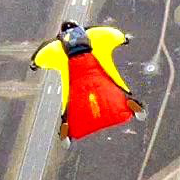Recommended Posts
Hooknswoop 19
QuoteWell, since you have not been maintaining gear on a 180 day cycle, your estimate of the condition of the rigs after 180 days is speculation (but not your observation of the condition after 120 days.) OTOH the observations of other riggers who maintain rigs on a 180 day cycle are pretty factual, when it comes to what a rig will look like after 180 days.
Right, I can safely say that for too many rigs, extending the re-pack cycle would be a bad idea. I don't need to hear what happens in other countries, I see the condition of rigs after 120 days and 180-days would just be worse.
Derek
QuoteRight, I can safely say that for too many rigs, extending the re-pack cycle would be a bad idea. I don't need to hear what happens in other countries, I see the condition of rigs after 120 days and 180-days would just be worse.
Yeee. That is a strait and perfect solution. What a freedom you have! Sure that is the right way to solve attitude problems.
Hooknswoop 19
QuoteYeee. That is a strait and perfect solution. What a freedom you have! Sure that is the right way to solve attitude problems.
I'm not sure I understand what you are saying.
Derek
Hooknswoop 19
QuoteYeee. That is a strait and perfect solution. What a freedom you have! Sure that is the right way to solve attitude problems.
Um, OK, let me be more specific.
What solution are you refering to?
What freedom are you refering to?
What attitude problems are you refering to?
Derek
gemini 0
QuoteIf your'e ok with the increased odds of somthing happening out of your control get your RATING and stop whining about the cost. When you pack your own rig it will be FREE! and when you pack someone elses rig you will be on your way to RICHES! Of course you will want to stash a portion of this newly found disposable income for any future litigation you may be involved in due to your increased exposure. Have fun with it.
Hook, just wanted facts from the guys already seeing 180 day cycles. If they all say go back to 120 days for safety sake, then that woulda' been the end of it.
Just suspicious of anyone who benefits (regardless of the amount) making broad statements against something like this.
Mick, play nice now!
Blue skies,
Jim
Which is kind of what I was getting at earlier. Perhaps their attitude would change if the repack cycle was extended to 180 days. Perhaps it wouldn't.
If the attitude some skydivers have about gear maintenance changed (improved), the argument you've presented against a 180 repack/inspection diminishes.
It seems to me that they are two different issues and should be addressed as separate issues. No matter how long the repack cycle is skydivers should take their gear maintenance very seriously. Their life saving device is literally in their hands, not the rigger's. Riggers only see the equipment every 120 days or longer.
I understand the argument for 120 days is based on 'safety'. Although I don't see there isn't any quantifiable degree of saftey that is related to the length of the repack cycle. Would a 100 day repack cycle be more safe than 120? Why? By how much? How much worse would a 130 day repack cycle be? Why? How much worse?
It's hard to quantify because the answer is dependent on the attitude of the owner of the equipment. If they take care of their gear a 360 day repack cycle could be a totally reasonable proposition.
Ken
Ken


.thumb.jpg.4bb795e2eaf21b8b300039a5e1ec7f92.jpg)



>another country is seeing are facts?
Well, since you have not been maintaining gear on a 180 day cycle, your estimate of the condition of the rigs after 180 days is speculation (but not your observation of the condition after 120 days.) OTOH the observations of other riggers who maintain rigs on a 180 day cycle are pretty factual, when it comes to what a rig will look like after 180 days.
As a side comment, we haven't seen problems with rigs that go between six months and two years between repacks (Amy's been getting a lot of foreign rigs to repack lately.) We tend to see more problems with heavily-used local rigs on the more standard 120 day cycle. The problems crop up over the course of a few years, though, not within four months.
Share this post
Link to post
Share on other sites